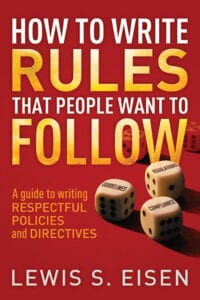
We always hear the quote, ‘rules are meant to be broken.’ Consequently, people have been breaking the rules and getting into trouble. How, then, can we make them follow us, instead of disobeying?
In this episode, I speak with Lewis S. Eisen, author of the international bestselling book, ‘How to Write Rules that People Want to Follow: A Guide to Writing Respectful Policies and Directives.’ In this value-packed episode, Lewis provides a unique view that emphasizes the role of law-makers in making it possible for people to follow rules.
Check out this episode if you want to learn:
- How to write your policies so that your team will gladly follow them
- When not to create a policy
- The unexpected ways that good policies can attract talent
🎧 Listen to the podcast here:
Writing Rules That People Will Follow With Lewis S. Eisen
What inspired you to write a book about policies?
I’ve worked at a number of government organizations. When I got to one of the large ones, my team came up to me and said, ‘We have a compliance problem. We have all these rules and nobody is listening.’ I took a look at the policies. They were full of bold and italic sentences in all capital letters, with harsh words like, ‘No exceptions will be made’. I realized that policies have a tone of voice and, coming from a legal background, there’s a methodology to writing legislation that’s straight-forward (so) you can spend your time discussing the content, not the style.
In your book, you made the statement that well-written policies don’t sound like angry parents talking to their naughty children. What was the difference between a well-written policy versus a poorly-written policy?
The goal of a policy is to help a business function properly. A poorly-written policy is one that doesn’t move you in that direction.
There are a couple of things that could do that. One is a lack of clarity: it’s not clear what decision you’ve made. The second is an attitude that gets people’s back up. The parents yelling at their children — that’s common in policies that you see nowadays. It’s an old style. It comes from the days when we had a hierarchical work structure, when the people on the top used to talk like that to the people that worked for them, and nobody spoke back.
'The purpose of the policy is to clarify the expectation.' Share on XWhat’s an example of a well-worded policy, versus a poorly-worded one?
We’re in the middle of a COVID crisis, and one example is a policy that says, ‘Customers must wear a mask while in the store, no exceptions’. It is a poorly-worded policy, and a very common one. First of all, it’s quite divisive. It separates the customers from you. You’ve immediately said, ‘You are not one of us. This is your problem, the customer, so we are giving you an order.’
The second problem is using terms like ‘must’ and ‘should’. They are judgment-based. Instead of saying something like, ‘Our policy is that customers wear masks in the store’, saying ‘Our policy is the customers must wear masks in the store’ — (it) immediately brings you to the parent-child dynamic, instead of an adult-adult dynamic.
Some might say that certain adults need to be spoken to in a direct manner like children, because given the choice, they may choose not to comply.
That’s true, there are people that need to be spoken to in that stricter tone of voice. The problem is, as a business, you do not want to cater to those people, because when you do that, you alienate everybody else. The sign in the coffee shop that says, ‘No yelling, no swearing, no spitting’ — you might look at that and think, ‘I wouldn’t do that anyway’, but you also wonder, ‘What goes on at this coffee shop that they have to put that sign up there?’
In your experience, what have you found has been helpful for managers who are trying to keep their people motivated, but still feel like they need to have a cloud over their heads, like they’re Big Brother?
When you look at an organization and you see a lot of policies with harsh language, that usually tells you that there is no proper enforcement mechanism in that organization. Because there’s no enforcement mechanism, they end up yelling at people, because there are some people who don’t hear it the first time. If the only tool you’re going to give them is words, they keep adding words to the policy.
Enforcement is a different problem than policy. The purpose of the policy is to clarify the expectation. You tell people whether you want things to be red, green, blue, or yellow. It’s not the job of policy to tell them how you’re going to punish them if they don’t follow that. You have a HR regimen, and all your policies should be subject to however your employee discipline happens.
When somebody signs up to be an employee, they agreed to follow all policies — present and future. The mechanism that you have for the bad employee or the employee that needs more discipline doesn’t belong inside the document that explains how to do things right.

How to Write Rules That People Want to Follow: A Guide to Writing Respectful Policies and Directives
Instead of writing for the lowest common denominator, you’re writing to a larger portion of the population.
There are many workplaces that would like everybody to clean their station at the end of the day. It could be a bakery, a factory, or even an office. If you had a policy like, ‘Everybody must clean their desk at the end of the day’, you’re not getting anywhere. All you do is sound like a parent nagging their kid to clean their room.
The better thing to do is to help articulate what a clean workspace looks like. I had an organization that had a lot of playrooms for children, and they had never articulated, ‘(Clean) means toys on the shelf. It means cupboard doors closed. It means no visible papers’.
If you put (people) in a position where they define what (clean spaces) look like, then they could have a discussion over the logistics of what constitutes a clean workplace — rather than mommy scolding you and telling you to clean up your room.
What underlies a well-worded policy is giving people an understanding as to the ‘why’. I think back to Simon Sinek’s ‘Start With Why’. People will engage and be more attentive when they understand the reasons behind what is being shared or sold, versus being told what to do.
Without (the ‘why’), people think you’re making rules for the sake of rules.
The other element that shouldn’t be in the policy is micromanagement. For instance, if you have a policy that says, ‘the HR lead needs to consider the complaint and make a decision’ — if they need to make a decision, they have to consider the complaint. By putting that in the policy, you are micromanaging them. It’s like, ‘Please sign here to show that you’ve read and understood this document.’ You can’t have understood it if you didn’t read it. That’s micromanagement, and that doesn’t belong in the policy.
'If you're going to implement change in your organization, what you need to change is the culture.' Share on XA while ago, I was working with an organization. One employee had a death in the family. Managers had a certain level of discretion when it came to how much leave employees could take for bereavement. Many companies have policies around this, but in this organization, the manager was asking, ‘Is this person struggling? How much latitude do I have, what’s going to be fair to them?’
If you’re going to implement change in your organization, what you need to change is the culture. You can put all the threats in the world inside a policy, but it’s not going to change anything unless you change the culture. Your decision — even if you’re giving the manager discretion — is ‘what kind of culture do you want to be supporting there, what kind of values do you want to be supporting?’ Are they more empathetic, or are they more the necessity of operation? The policy that you write should support the culture that you want to replicate.
It sounds simple, but it’s not.
It’s simpler than people think. When people say, ‘I need a policy. What are the rules that I should give people?’ — that’s not the right approach, because that doesn’t address the culture or the strategy. The better approach is to say, ‘How do I want this organization to work? Let me describe that in writing.’
If you were to say to everybody, ‘I think we should all clean our workspace at the end of the day,’ and everyone went, ‘Good,’ and they do it — you don’t have to spend your time writing up a policy. It’s only once you’ve described the vision that you want to see and people come back and say, ‘I don’t know how I can do that’ — then you need to write a policy to clarify what it is you’re talking about.
Simply start by telling people what you’d like to see. Set your expectations. It’s no different.
That aligns with what you wrote in terms of policy and vision — reminding people to see the connection between the two.
That is the tightest connection there should be. The policy should support the vision and the values that you’re putting forward. That’s usually the ‘why’.
A number of times, people say to me, ‘The ministry insists that we have a policy on X’. In those cases, the word ‘policy’ is being used loosely in the legislation. If you have a document called ‘Procedure on X’, or you have written down what you’re going to do with X — it doesn’t have to be in a document called ‘Policy on X’. Nobody who inspects it is ever going to give you a slap on the hand for not putting the word ‘policy’ on the top of the document.
Especially if you’re a small organization, don’t worry about the formality of the policy document. Worry about writing something that everybody can understand and work with.
It’s easy to go to Staples, pick up boilerplates, fill in the spaces and then say, ‘I got something on paper to be compliant.’
The problem with that is that it’s a one-size-fits-all solution. You would never buy a one-size-fits-all suit.
Those policies that you get from the policy bank have that authoritarian tone of voice: ‘Employees must always do this. No exceptions.’ A woman named Suzanne once came to me and said, ‘Before I apply for a job, I asked to see the organization’s policies because I want to hear how they talk to their employees. If I don’t think they talk respectfully to their employees, I don’t work there.’

Writing Rules: The goal of a policy is to help the business function properly, and to help people work properly. A poorly written policy is one that doesn’t move you in that direction.
Those boilerplate policies that you bring in — they reflect on your organization, whether you think they do or not. Good employees are hard to find. Somebody who does their due diligence like that, that’s exactly the kind of person you would want. If your policies comes across with this authoritarian tone of voice, it will work against you.
You often hear ‘our policy is’ — it can become a scapegoat for poor service or poor behaviour. Then, when you press upon it, you learn that the policy isn’t written anywhere.
You have a tension between the people who want all the details written down — which would take an enormous amount of process and energy — and the people who would like things to be fluid. It says something if every single thing has to be written down in an organization. There’s a problem with the way that the organization runs. It cannot sustain that.
How do you help organizations change their policies?
I normally run workshops. We look at: what’s the purpose of writing a policy, and when do I need to write a policy? How can I word it so that people won’t get their backs up?
If I can give you a real human example of that. I was in a work-sharing space where I (was) giving a talk. The director came over to me after and says, ‘There’s one person who sits in the corner and whenever he’s on a conference call, he’s loud. I guess we need (a) policy to have him not talk so loud.’
That’s a knee-jerk reaction where what you have is a human problem. That is not a policy issue. Every organization has to make the decision (by asking): how widespread is the problem, and how much are people pushing back against the solution?
We saw the same thing when cannabis became legal in Canada. A number of people said, ‘I don’t want people to show up to work stoned. I need a policy.’ Most organizations already have policies about people showing up to work when intoxicated or unable to perform for whatever reason. Every time something new comes up, we don’t need a policy to resolve it.
That’s what I work with through a workshop: when do you need the policy? How can we word it so that you’re likely to get as much buy-in as possible? (Afterwards), the culture is so much better. They stop seeing whoever’s writing the policy as the (enforcer), and start seeing them as a business partner.
'When people stop seeing each other as enforcers, they start seeing who’s writing the policy as a business partner.' Share on XYou bring up something that’s key to understanding how we relate to one another — knowing the people around you, and what’s going to best bring out the best in people.
The best wording I always tell people is the statement, ‘Office hours are 9 to 5’. That’s a simple statement of the way you do things. There’s no threat. It’s not about me doing it to you. We’re not talking mandatory and optional — we’re describing the way we want things to be. That’s an adult-adult dynamic.
📌 Important Links:
- Lewis Eisen
- ‘How to Write Rules That People Want to Follow: A Guide to Writing Respectful Policies and Directives’ by Lewis Eisen
- ‘Start With Why’ by Simon Sinek
Love the show? Subscribe, rate, review, and share!
Join The Leader’s Chair Community today on Facebook and Twitter.





